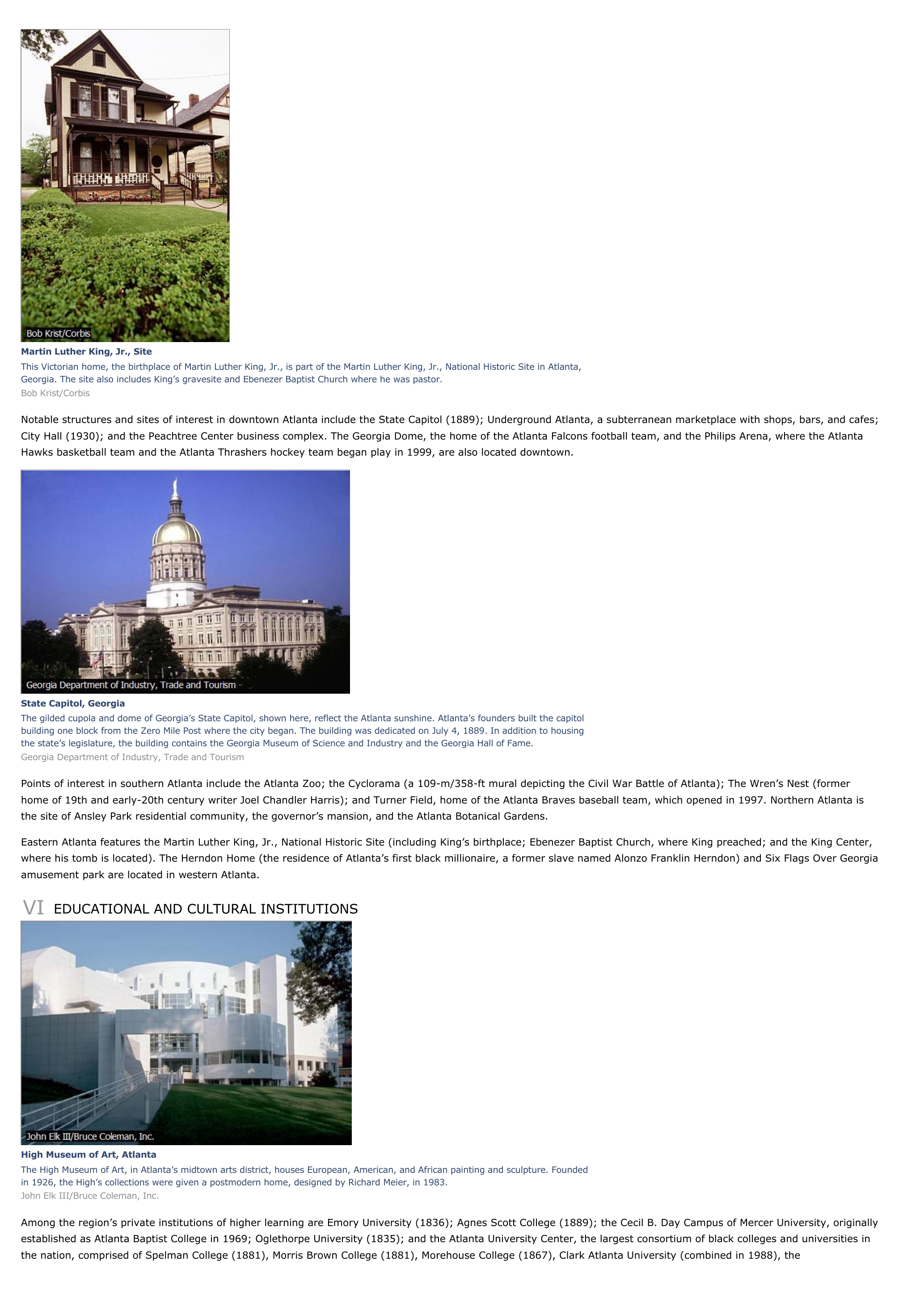Atlanta - geography.
Publié le 27/05/2013

Extrait du document
«
Martin Luther King, Jr., SiteThis Victorian home, the birthplace of Martin Luther King, Jr., is part of the Martin Luther King, Jr., National Historic Site in Atlanta,Georgia.
The site also includes King’s gravesite and Ebenezer Baptist Church where he was pastor.Bob Krist/Corbis
Notable structures and sites of interest in downtown Atlanta include the State Capitol (1889); Underground Atlanta, a subterranean marketplace with shops, bars, and cafes;City Hall (1930); and the Peachtree Center business complex.
The Georgia Dome, the home of the Atlanta Falcons football team, and the Philips Arena, where the AtlantaHawks basketball team and the Atlanta Thrashers hockey team began play in 1999, are also located downtown.
State Capitol, GeorgiaThe gilded cupola and dome of Georgia’s State Capitol, shown here, reflect the Atlanta sunshine.
Atlanta’s founders built the capitolbuilding one block from the Zero Mile Post where the city began.
The building was dedicated on July 4, 1889.
In addition to housingthe state’s legislature, the building contains the Georgia Museum of Science and Industry and the Georgia Hall of Fame.Georgia Department of Industry, Trade and Tourism
Points of interest in southern Atlanta include the Atlanta Zoo; the Cyclorama (a 109-m/358-ft mural depicting the Civil War Battle of Atlanta); The Wren’s Nest (formerhome of 19th and early-20th century writer Joel Chandler Harris); and Turner Field, home of the Atlanta Braves baseball team, which opened in 1997.
Northern Atlanta isthe site of Ansley Park residential community, the governor’s mansion, and the Atlanta Botanical Gardens.
Eastern Atlanta features the Martin Luther King, Jr., National Historic Site (including King’s birthplace; Ebenezer Baptist Church, where King preached; and the King Center,where his tomb is located).
The Herndon Home (the residence of Atlanta’s first black millionaire, a former slave named Alonzo Franklin Herndon) and Six Flags Over Georgiaamusement park are located in western Atlanta.
VI EDUCATIONAL AND CULTURAL INSTITUTIONS
High Museum of Art, AtlantaThe High Museum of Art, in Atlanta’s midtown arts district, houses European, American, and African painting and sculpture.
Foundedin 1926, the High’s collections were given a postmodern home, designed by Richard Meier, in 1983.John Elk III/Bruce Coleman, Inc.
Among the region’s private institutions of higher learning are Emory University (1836); Agnes Scott College (1889); the Cecil B.
Day Campus of Mercer University, originallyestablished as Atlanta Baptist College in 1969; Oglethorpe University (1835); and the Atlanta University Center, the largest consortium of black colleges and universities inthe nation, comprised of Spelman College (1881), Morris Brown College (1881), Morehouse College (1867), Clark Atlanta University (combined in 1988), the.
»
↓↓↓ APERÇU DU DOCUMENT ↓↓↓
Liens utiles
- Atlanta - geography.
- Mitchell Margaret, 1900-1949, née à Atlanta (Géorgie), romancière américaine.
- Lee (Shelton Jackson , dit Spike), né en 1957 à Atlanta (Géorgie), acteur et cinéaste américain.
- King Martin Luther , 1929-1968, né à Atlanta (Georgie), pasteur noir américain.
- Hardy Oliver, 1892-1957, né à Atlanta (Georgie), acteur américain.

































